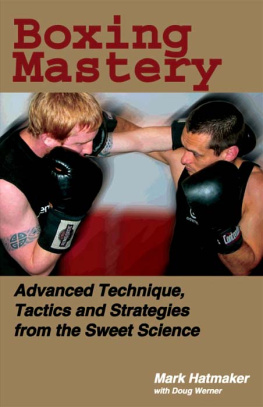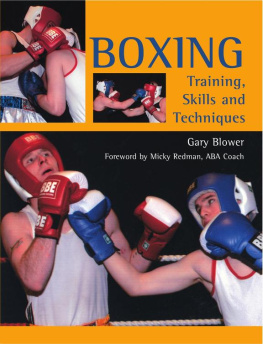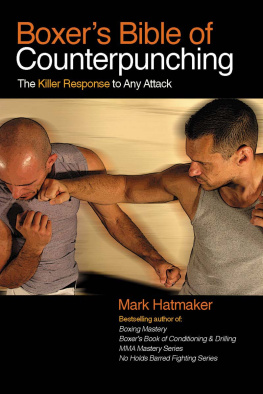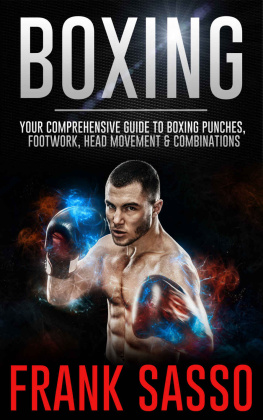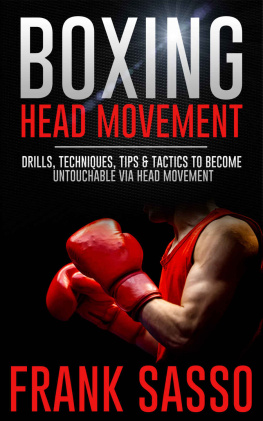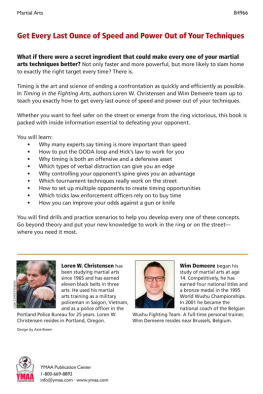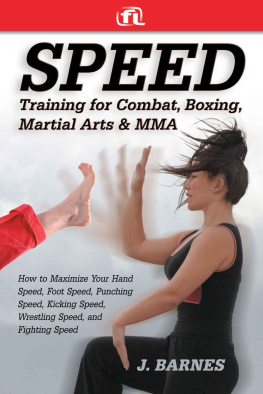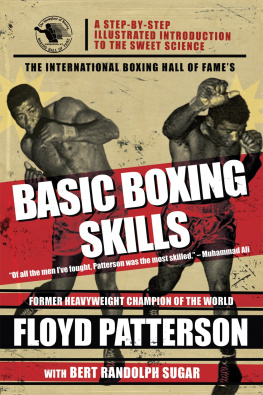All rights reserved. No part of this book may be reproduced or
transmitted in any form or by any means, electronic or mechanical,
including photocopying, recording or by any information
storage and retrieval system without permission from the author,
except for the inclusion of brief quotations in a review.
Hatmaker, Mark.
p. cm.
Includes index.
1. BoxingTraining. I. Werner, Doug, 1950
II. Title.
GV1137.6. H38 2004 796.83
Acknowledgements
in alphabetical order
Aisha Buxton for production
Phyllis Carter for editing
Kylie Hatmaker for set production
Kory Hays for showing and sharing his talent throughout this guide
Margaret Simonds for production
Students and teachers past and present for making every day a learning opportunity
Warning label
Boxing includes contact and can be dangerous.
Use proper equipment and train safely. Practice with restraint and respect for your partners. Drill for fun, fitness and to improve skills. Do not fight with the intent to do harm.
Since padded gear can block and shadow important views, fighters shown in this book did not wear sparring gloves or protective gear in order to better show technique. Author and publisher do not advocate boxing without proper equipment.
Introduction

If you browse any bookstore looking for contemporary boxing books, you will find a few biographies of past great fighters and a smattering from the present. You will find also many titles regarding fitness boxing. Fitness boxing is a curious animal. It is nothing more than taking the bare bones of the professional boxers conditioning regimen and cleaning it up for mass consumption. Fitness boxing removes the bumps and bruises and glosses over the hard-core approach to a fighters training program. The result is a toothless bastardization of a noble sport.
I understand the urge and visceral attraction to becoming fit by going though the motions that truly tough human beings perform. But most of these workout books are pale imitations of the real thing and poorly represent the sweet science. These contemporary volumes may show you some punches and a few combinations, but they have removed the science from the sweet science.
With the exception of the two fine volumes by Doug Werner and Alan Lachica, Boxers Start-Up and Fighting Fit (Tracks Publishing) you will find little to nothing in print that covers the deceptive tactics, strategies and advanced maneuverings of the fight game. Boxing Mastery reintroduces the scientific and strategic beauty of the sport above fitness and slugging. I seek to put the brain back into the athlete who wants to use his entire body to best effect.
This book is intended for the fighter who already knows the basics. If you are a novice, there is much to be learned here, but I urge you to take a look at the two boxing titles listed in the Resources section as well as the recommended video instruction. Boxing Mastery is intended to be a source book of strategies and tactics for the real boxer the individual who wants to take the sport beyond a trendy cardio activity and test his mettle with an actual opponent.
You will not find every tactic and tip ever accrued in the ring between these covers. That would call for a much larger volume. You will find plenty to mull over, whether youre green to the ring or have pro fights to your credit. Training equipment, conditioning, speed bag work, double-end bag tips, maize ball drills, rope-skipping, plyometric exercises and the like are not included here. My primary task is to enlighten the fighter in the realm of ring generalship. And generalship it is. For boxing is more than survival of the fittest. It is a game of conditioned reflex action, destructive deception and coordinated, exquisitely articulated physical combat. Indeed, boxing is a science. And a sweet one at that.
Lead and rear hands
a special note
Probably a first in the annals of boxing books, both fighters in this book (Mark Hatmaker and Kory Hays) are southpaws. No problem. Right and left leads will get the same benefit from this guide because hands are labeled lead and rear, not right or left. Read the material and as you look at the photos, adjust according to your preference.


1 The
training
continuum

There is a ton of information in these pages. If you are an experienced fighter, feel free to jump in anywhere. I recommend the novice start at the beginning and work through the end of the book. No matter your skill level, I recommend you take each technique or tactic and work it through the following training continuum to ensure that the information is deeply seated into your nervous system.
Mirror training
I know it is tempting to take a new idea and run immediately to the heavy bag or get in front of an opponent, but the most important piece of equipment you can own is a full-length mirror. The mirror is absolutely the best tool for self-correction. By working before a mirror, you provide your own feedback about your movement, technique and guard. Is as tight, fluid and powerful as need be? Work everything in front of the mirror footwork, offense, defense and upper body movement. Keep this fact in mind: If it aint right in front of the mirror, it aint gonna be right anywhere else.
Equipment training
After youve honed your tools in front of the mirror, it is time to apply them to solid targets. Take the selected technique or tactic and apply it to the training apparatus that will best accomplish the desired result. In other words, select the device that will provide the most realistic feedback for that particular tool. In broad strokes, (there are exceptions) use the heavy bag for working power, the double-end bag for timing and accuracy, the maize bag for defense, slip-sticks for upper-body mobility and so on. With this information in mind, choose wisely.

